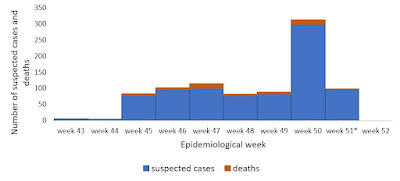On 8 December 2024 the World Health Organization and Ministry of Health of the Democratic Republic of Congo reported an outbreak of an unknown disease in the Panzi Health Zone of Kwango Province, which had infected 406 people and killed 31 people (a case fatality rate of 7.8%) between 24 October and 5 December 2024. The symptoms of the disease include fever, headache, cough, runny nose, and body ache, and it was particularly hazardous to children, with 71% of fatalities in under-fifteen-year-olds. The remote nature of the area affected, which lacks both any form of diagnostic laboratory and good transport links to anywhere that does, were making it hard to determine the cause of the disease, although specialist teams were being dispatched to the area to try to resolve the situation at that time.
An updated report on the situation published by the World Health Organization on 27 December 2024 noted that since the initial report a further 485 cases of the disease had been reported in 25 of the 30 Health Areas which make up the Panzi Health Zone before 16 December, with an additional seventeen deaths. All the victims appeared to be suffering from a combination of febrile illness with acute respiratory symptoms and anaemia, all of which are common symptoms of infections around the onset of the rainy season in the Democratic Republic of Congo, but the number of deaths is far higher than would normally be expected.
In he absence of a clinical diagnosis of the disease, health workers adopted a surveillance-based case definition, which included people living in the Panzi Health Zone from September 2024 suffering from fever and/or a cough and/or body weakness and/or a runny nose, with or without any of chills, headache, difficulty breathing, malnutrition, or body aches.
From 24 October to 16 December 2024, 891 patients were treated for illnesses which matched these infections, with 48 recorded fatalities. Children were disproportionately impacted, with 47% of cases and 54% of fatalities among those under five years old (who make up about 18% of the population). Those who died were disproportionately likely to be suffering from difficulty breathing, anaemia, and acute malnutrition.
Four hundred and thirty blood samples, oropharyngeal and nasopharyngeal swabs, urine and breastmilk samples were collected from patients and transported to the Institut National de Recherche Biomédicale in Kinshasa. Eighty nine of these samples have been tested to date (further tests are ongoing), sixty four of which have proved to be positive for common respiratory infections, including the H1N1 Influenza Virus (25 cases), Rhinoviruses (18 cases), COVID-19 (15 cases), other Coronaviruses (3 cases), Parainfluenza Viruses (2 cases), and Human Adenovirus (1) case. In addition, 88 samples were subject to rapid diagnosis tests for Malaria in the field, with 56 (62%) being positive.
Based upon these findings, health workers in Panzi Health Zone have concluded that the 'epidemic' has been caused by a combination of common Viral respiratory infections combined with Malaria and acute malnutrition.
The number of both cases and deaths has remained steady since the onset of monitoring, with the exception of a spike in the number of reported cases in the week ending 15 December, which may relate to either the onset of the seasonal rains or the deployment of rapid response teams carrying out additional surveillance work; notably, this rise in the number of cases detected was not matched by a rise in the number of fatalities reported.
More cases of infection have been reported in females than males (58%), however, this is disproportionately true of adults (68% of adult infections), and may therefore reflect the role of women in looking after sick children, and therefore being more likely to become infected within households, rather than a greater biological vulnarability to any of the infections involved.
The affected area has been suffering from a deterioration in food security for some months, with a subsequent increase in the number of cases of acute malnutrition. Between July and December 2024, a period which should normally coincide with a drop in the number of cases of acute malnutrition, Kwango Province was deemed to be in Acute Malnutrition Phase 3 (Serious) under the Integrated Food Security Phase Classification system. Between January and June 2025, a period when the situation would be expected to get worse most years, it is probable that the province will move to Acute Malnutrition Phase 4 (Critical). It is predicted that between July 2025 and June 2024, 4.5 million children between the ages of six months and five years will face acute malnutrition in the Democratic Republic of Congo, with 1.4 million cases of severe acute malnutrition (defined as acute malnutrition which is immediately life-threatening without medical treatment) expected. During the same period 3.7 million pregnant and breastfeeding women will also face acute malnutrition in the country.
The effects of disease and malnutrition combine and intensify one-another. Panzi Health Zone has poor vaccine coverage, poor access to diagnostic equipment, and little of the infrastructure needed for effective case management. The area has a shortage of health workers, lacks supplies of medical equipment, and is poorly connected to the outside world by transport networks. The onset of the rainy season is expected to bring a steep rise in the number of Malaria infections, and the combination of problems is likely to make the population more vulnerable to both Malaria and common respiratory infections.
See also...






.jpg)
.jpg)


